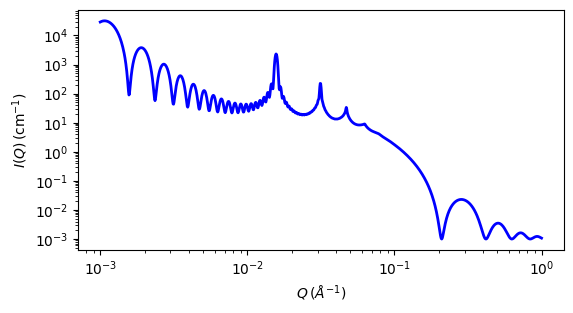lamellar_stack_caille¶
Random lamellar sheet with Caille structure factor
Parameter |
Description |
Units |
Default value |
|---|---|---|---|
scale |
Scale factor or Volume fraction |
None |
1 |
background |
Source background |
cm-1 |
0.001 |
thickness |
sheet thickness |
Å |
30 |
Nlayers |
Number of layers |
None |
20 |
d_spacing |
lamellar d-spacing of Caille S(Q) |
Å |
400 |
Caille_parameter |
Caille parameter |
Å-2 |
0.1 |
sld |
layer scattering length density |
10-6Å-2 |
6.3 |
sld_solvent |
Solvent scattering length density |
10-6Å-2 |
1 |
The returned value is scaled to units of cm-1 sr-1, absolute scale.
This model provides the scattering intensity, \(I(q) = P(q) S(q)\), for a lamellar phase where a random distribution in solution are assumed. Here a Caille \(S(q)\) is used for the lamellar stacks.
Definition
The scattering intensity \(I(q)\) is
The form factor is
and the structure factor is
where
Here \(d\) = (repeat) d_spacing, \(\delta\) = bilayer thickness, the contrast \(\Delta\rho\) = SLD(headgroup) - SLD(solvent), \(K\) = smectic bending elasticity, \(B\) = compression modulus, and \(N\) = number of lamellar plates (n_plates).
NB: When the Caille parameter is greater than approximately 0.8 to 1.0, the assumptions of the model are incorrect. And due to a complication of the model function, users are responsible for making sure that all the assumptions are handled accurately (see the original reference below for more details).
Non-integer numbers of stacks are calculated as a linear combination of results for the next lower and higher values.
The 2D scattering intensity is calculated in the same way as 1D, where the \(q\) vector is defined as

Fig. 49 1D plot corresponding to the default parameters of the model.¶
Source
lamellar_stack_caille.py
\(\ \star\ \) lamellar_stack_caille.c
References
F Nallet, R Laversanne, and D Roux, J. Phys. II France, 3, (1993) 487-502
J Berghausen, J Zipfel, P Lindner, W Richtering, J. Phys. Chem. B, 105, (2001) 11081-11088
Authorship and Verification
Author:
Last Modified by:
Last Reviewed by: